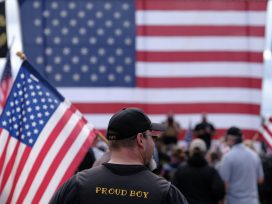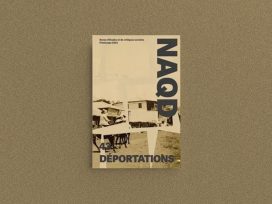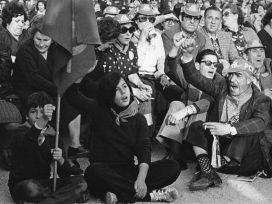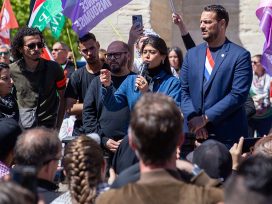It is almost futile to try to pinpoint the ideological underpinnings of antifa. Natasha Lennard in her writings speaks of Foucault and ‘microfascisms’, but in America, antifa groups seem to be inspired more by the anarchist Hakim Bey and his proposal to create ‘temporary autonomous zones’.
Mark Bray, in his Antifa: The Anti-Fascist Handbook describes it as ‘a transnational movement that adapted preexisting socialist, anarchist, and communist currents to a sudden need to react to the fascist menace’.
Along with this hodgepodge of contradictory left-wing trends that it claims to unite, antifa’s definition of fascist is a vague one. Essentially, a fascist is a fascist is a fascist. Fascism is like pornography: I can’t define it, but I know it when I see it.
In other words, antifa is best understood not as an idea, but rather as a form of praxis, summed up, as the German anti-Nazi fighters of the 30s put it, as ‘Strike the fascists wherever you see them.’
Or, as Bray puts it, antifascism ‘is a legitimate political tradition growing out of a century of social struggle’. And yet, antifa, as Bray unwittingly proves in his book, fails to take account or advantage of the richness of the struggles of the past century, restricting itself to shutting down fascists by whatever means necessary.
In his survey of the precursors to antifa in America, Bray begins his book with a brief, tendentious history of interwar antifascism. He focuses on the Italian Arditi del Popolo and the Weimar period Roter Frontkämpferbund (RFB) in Germany.
The Arditi del Popolo was a non-party organization that drew from all elements of the Italian left, from individualist anarchists to Communists (whose leadership – notably the future ultra-left communist Amadeo Bordiga – disavowed the organization). It was founded in 1921 to fight the Fascist squadristi, who were responsible for more deaths in Mussolini’s drive to power than were the more notorious SA in Germany.
The RFB was the fighting arm of the German Communist Party (KPD) and engaged in a series of street battles with Nazis that resulted in hundreds of deaths on both sides. It was armed fighters of the RFB who killed Nazi martyr Horst Wessel, author of the Nazi anthem, the ‘Horst-Wessel Lied’, which in fact mentions the Roter Frontkämpferbund. It was also a hit squad from the KPD’s Parteiselbstschutz, heir of the banned RFB, that murdered two police captains in Berlin in 1931. (One of the killers, Erich Mielke, later became the head of the East German Stasi.)
Bray regards contemporary antifa, both here and abroad, as heir to the tactics of these two groups. The comparison, however, is profoundly misleading. The Arditi del Popolo were not ephemeral groupings fighting largely phantom and marginal enemies, establishing ‘autonomous zones’ and doxing their enemies. Rather, they were organized militarily into battalions and had 20,000 members in 144 sections just weeks after the group’s founding. The RFB, even more tightly organized, had uniforms, and its leadership came from the KPD in the person of its Secretary, Ernst Thälmann (murdered by the Nazis in 1944 after spending eleven years in prisons and concentration camps).
Both the Arditi del Popolo and the RFB were serious about armed struggle in the streets. The antifascist writer Gaetano Salvemini reported that between 1920 and 1922, 406 leftists were killed, as were 303 fascists. In the first five months of 1921 alone there were 1073 battles between fascists and anti-fascists. Though it was the fascists who were almost always the attackers, 1421 leftists of various sorts were arrested, and only 396 fascists. Blackshirts burned down union and leftwing offices, shot and killed mayors and political figures, poured castor oil down the throats of their enemies. In Germany official statistics for 1931, for example, list 4,699 Nazis victim of political violence, against 1696 for the republican Reichsbanner, 1228 Communists, and 625 members of the rightwing Stahlhelm.
Besides hymning the virtues of the Italian and German left’s street fighting organizations, Bray also recounts the ‘Battle of Cable Street’, when antifascist protesters took on Oswald Mosley’s British Union of Fascists (BUF) as the BUF marched through the Jewish East End of London on 4 October 1936, despite the pleas of residents to ban the march.
As it happened, only two to three-thousand of Mosley’s followers showed up. Hoping to protect the marchers and also prevent violence, the Metropolitan Police mustered some 7,000 troops, some mounted. The BUF and the police were met by a much larger crowd of 20,000 antifascist protesters from a variety of left groups: anarchist, communist, and socialist. Mosley’s marchers retreated to Hyde Park, leaving the antifascists, armed with rocks, sticks, and other improvised weapons, to fight with the police.
Although Bray himself concedes that ‘the fact that the Battle of Cable Street helped fascist recruitment, triggered fascist violence, and was viewed negatively by Jewish community leadership and the majority of the British public’, he insists that these consequences do ‘not prove that it was a strategic error’. After all, Mosley and his followers were forced to retreat!
With his focus on antifascist fighters, Bray entirely ignores the best example of successful anti-fascist struggle, that of France in the years 1934–1936. Not only was fascism checked there, but in the space of two years a Socialist-led government ruled the country.
The crisis in France exploded on 6 February 1934, when the far-right – from nationalists to royalists to fascists – demonstrated against the government. Battles with the police broke out on the Place de la Concorde, leaving fourteen dead. A coup was feared, and the fascist threat seemed real. On that same day, before the demonstration had even taken place, the French Communist Party’s (PCF) newspaper, L’Humanité, issued a list of demands, including the dissolution of the fascist leagues. While condemning the leadership of the Socialist Party, the paper called for Communist and Socialist workers to unite, but in essence maintained the line that had led the KPD to disaster, that of class against class and a united front from below, i.e. without the involvement of leaders.
But the rank and file workers viewed things differently. When a general strike was called for 12 February, socialists and communist workers, in separate marches, joined together to cries of ‘Vive l’unité’. In June, at a party congress, Communist leader Maurice Thorez announced that ‘We want, at whatever the cost, to accomplish unity in action with the socialist workers against fascism … We want to bring over to us the middle class, wresting them from fascist demagoguery’. The working class’s interest now lies in ‘not underestimating the defence of democratic liberties’. And in what would be a key element of future policy, Thorez said, ‘We love our country’.
On 27 July 1934, a unity-in-action pact was signed between the two parties of the left, and in the cantonal elections in October the two parties cooperated in elections, Socialists supporting Communists who passed to the second round of voting and vice versa. The drive to bring the middle class into the fight was accomplished with the Radical Party’s joining the Popular Front that same fall.
Within the first year of the Popular Front, the number of municipalities run by the PCF doubled, as did party membership. Antifascist intellectuals flocked to the party and on Bastille Day 1935, 500,000 people marched from the Bastille to the place de la Nation. The red and tricolor flags flew together, and the ‘Marseillaise’ and the ‘Internationale’ were both sung. Party leader Jacques Duclos said at a rally that day that ‘We see in the tricolor flag the symbol of the struggles of the past, and in the red flag the symbol of the struggles and victories of the future.’
The movement reached its culmination in the spring of 1936, when the Popular Front – with the Communists refusing to accept any ministerial offices – swept the elections.
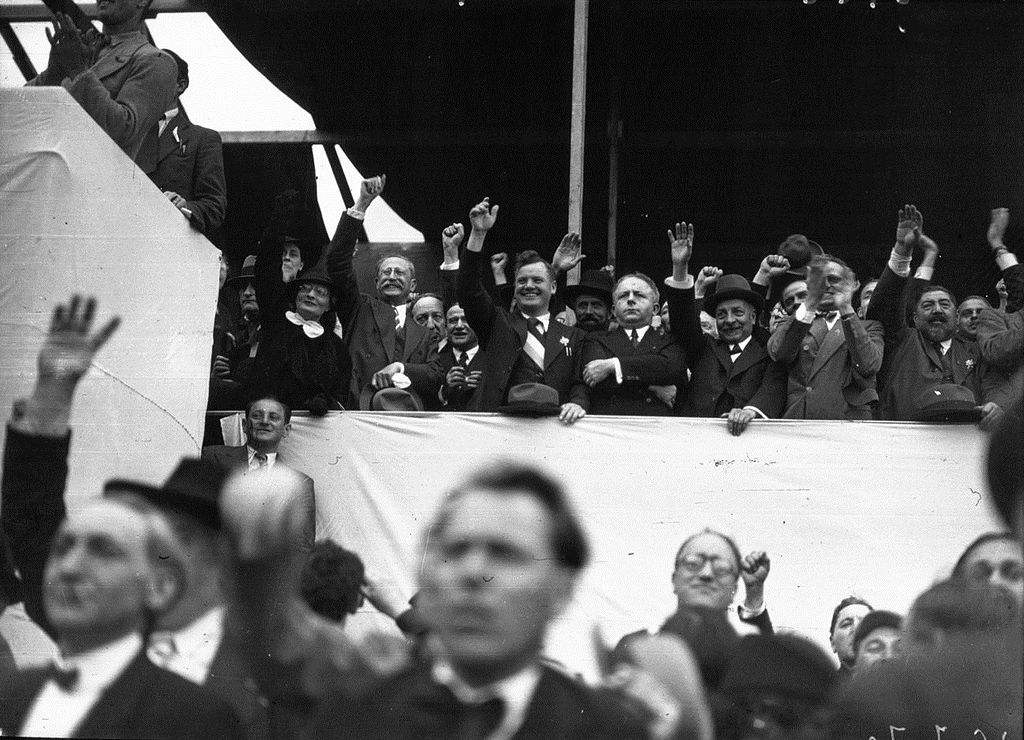
Popular Front demonstration 14 July 1936. Left to right: Thérèse Blum, Léon Blum, Maurice Thorez, Roger Salengro, Maurice Viollette, Pierre Cot. Via Wikimedia Commons
It was precisely due to its willingness to reach out to strata of the population that had traditionally been ignored by Communist parties that the Popular Front emerged victoriously. In a famous speech, the first given by a Communist on national radio, Thorez even ‘offered his hand’ to Catholics, ‘because you are our brothers’, and to veterans – many of whom had gone over to the far right – ‘because you are a son of our people’.
France’s past was enlisted in the cause of the left. Of the canonized Joan of Arc it was said, she ‘doesn’t belong to the royalists and Hitlerite fascists. The peasant girl of the Lorraine, who rose up against the allied factions of the foreigner and who was handed over by her king, belongs to the people of France.’
Unlike the Italian and German lefts, the French left not only pushed back the native fascist threat but managed to install a government that, after a massive general strike in May and June 1936, achieved demands previously unthinkable. The right to strike, to collective bargaining, to paid vacations, raises in salary, all were almost immediately implemented by the Popular Front government.
The Popular Front fell apart in early 1937 when Leon Blum called for a ‘pause’ in reforms, but it was only with the arrival of the Germans that a form of fascism was established in France. It’s worth noting that the government installed by the Germans for the most part excluded pre-war fascists and promoted a reactionary though not technically fascist God/family/farm ideology.
The French Popular Front, more than any other Popular Front, succeeded in bringing together broad sectors of the population. It did so, not only with a program of realizable, not revolutionary, reforms, but by making itself the heir of French history, not its enemy.
It is, however, not surprising that a victory over fascism at the ballot box should fail to interest Mark Bray, who describes antifa as ‘an illiberal politics of social revolution applied to fighting the Far Right, not only literal fascists’.
Its tactics of confronting fascists directly, of preventing them from speaking in public, of preventing them from organizing, of publicly revealing their identities have escalated over the course of the Trump presidency into street fights, shooting, and killings. Their vision of the fight against the right is an elitist one, one that cannot be adopted by the mass of the American public who must go to work, pay bills, and tend their children. In fact, antifa has become so elitist that in Washington, DC and Portland they have taken to verbally assaulting white people eating in restaurants or simply sitting at home for failing to join their demonstrations. They have arrogated to themselves the right to determine that everyone not with them is guilty of complicity in oppression.
By making violent confrontation the key element in fighting fascism, that fight is reduced to macho posing, not the work of serious political organizing. The confrontations between antifa and the far right might feel rewarding in the moment, but they do nothing to deflect the America’s current drift toward autocracy, and authoritarianism.
Proudly illiberal, antifa blithely walks down the ruinous path taken by those it claims as its predecessors. Indeed, the violent rhetoric and actions of antifa in America make it a convenient bogeyman for the president and his followers.
We can only hope that the recent battles between antifa, the Far Right, and police in Portland, Oregon, don’t have the same perverse political results as the Battle of Cable Street had in England in 1936 – when a similar melee helped the far right, and triggered yet more political violence. Thanks to antifa’s historical and political blindness, which plays directly into the hands of their enemies, the fascism germinating on the right and that for the moment lives mainly in antifa’s imagination, risks becoming a reality that will crush not only them, but all of us.


